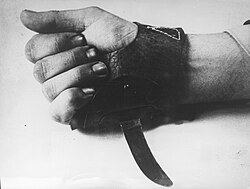This is an old revision of this page, as edited by Rjecina (talk | contribs) at 23:13, 25 July 2008 (revert to user Wafulz version. It is not possible to delete statements confirmed by NPOV internet links. About other things see talk page). The present address (URL) is a permanent link to this revision, which may differ significantly from the current revision.
Revision as of 23:13, 25 July 2008 by Rjecina (talk | contribs) (revert to user Wafulz version. It is not possible to delete statements confirmed by NPOV internet links. About other things see talk page)(diff) ← Previous revision | Latest revision (diff) | Newer revision → (diff)Miroslav Filipović (1915 - 1946) was a Franciscan friar from Bosnia and Herzegovina who, among other posts, commanded the Jasenovac concentration camp in Yugoslavia during World War II. As an extreme Croatian nationalist and fascist, Miroslav Majstorović (as he would become known) combined his religion with his extremist political ideology.
Pre-1942
He was born Miroslav Filipović, and became part of the Franciscan order in 1938 at the monastery in Petrićevac (near Banja Luka), when he took on the name "Tomislav" as his religious name. In January 1942, he had completed his theological exams in Sarajevo and was subsequently assigned as a chaplain in the Rama-Šćit region (northern Herzegovina). However, he returned to Petrićevac and instead of going to Rama, he signed up to become a military chaplain for the Ustaše, the Croatian fascist organization that controlled the so-called Nazi-puppet Independent State of Croatia.
The puppet state was formed after the destruction of the Kingdom of Yugoslavia by the Wehrmacht in 1941, and most of its military subsequently took part in warfare on the WW2 Yugoslav front of WW2, against the Yugoslav Partisans.
Drakulići massacre
Chaplain Filipović against church orders has joined Ustaše military like chaplain and was assigned to the 2nd Poglavnik Bodyguard Brigade in Banja Luka. On 7 February, 1942, they raided the Serb Orthodox villages of Drakulići, Šargovac and Motike located near the city because of collaboration with the rebels
During massacre more of 1,600 Ortodox were killed . Soon after this massacre church has started action against chaplain Filipović and his actions. Finding of the Provinical Definitory has been that he is guilty of joining a military organization against the express prohibition of gvardijan. It is uncertain whether he killed anybody, but because of the religious motivations he caused a great scandal and caused great harm to our church province and because of that he is removed as a brother from the monastic order excommunicated from the Roman Catholic Church .
During this investigation and latter Miroslav Filipović will say many times that he has not killed and that he has not called for killings
In infamous propaganda-documentary book Magnum Crimen (The Great Crime) written by Viktor Novak in 1948 Miroslav Filipović has started massacre with killings of school children after which he has given orders to soldiers to start killing everybody. It is interesting to notice that in book during killings school children are in school but massacre has been during night.
Due to his possible crimes against Serbian population, Germans occupiers has wanted to send Miroslav to court but he has been protected by Ustaše which has send him to Jasenovac camp.
Commander of the Jasenovac concentration camp
Filipović progressed in the Ustaša ranks and went by the name "Miroslav Majstorović". He became the commander of the Jasenovac concentration camp in autumn 1942. In the four months of Filipović/Majstorović's reign as camp commander, countless Serbs, Jews, Croats and Gypsies were tortured and executed.
He purported to continue in his role as a member of the religious order while commanding the camp, earning him the epithet "Fra Sotona" ("Father Satan") among the inmates. He wore friar's robes when giving confession and murdering prisoners in the camp.

Miroslav was singled in Jasenovac for several of his crimes:
He admitted to have killed some 100 inmates himself, an estimation which was shown as incorrect (low) by witnesses interviewed by the Yugoslav State Commission for the Investigation of Crimes of the Occupation Forces and their Collaborators'.
Additionally, the commission states that many of the inmates killed by Majstorović were killed "with his bare hands".
One of the interviewed witnesses, Tomo Karkac, stated as follows:
Very often during my imprisonment in Jasenovac I saw Majstorović shoot prisoners during so-called "public preformances." Majstorović also kept this short rubber hose, which he sometimes held over his victims wounds, saying: "I want to get drunk of communist and Jewish blood." I saw when Majstorović and Stojčić amused themselves by killing three gypsies, ordering the first to kill the second with a sledgehammer, the third to kill the first, and then they liquidated the last one.
In November 1942 then notorius Miroslav Filipović during discussion with priest Branimir Župančić has recognized his Jasenovac crimes and explained his first extermination camp killings, but he has again declared himself innocent of Drakulići massacre
Post-war
After the war, he was put on trial for war crimes, where he claimed a personal daily kill tally of at least one hundred people, including children. It is unclear whether this referred to the four months of his commandment of Jasenovac, or to the entire course of his involvement in the war (around four years). In the former case, that would amount to twelve thousand victims; while in the latter case it is likely hyperbole because it would imply he single-handedly killed 146,000 people, which is highly improbable.
Filipović/Majstorović was sentenced to death. He was hanged wearing the friar's robes he often wore in the camp.
References
See also
External links
- Pavelić Papers documents related to Filipović/Majstorović
- Dr. Nikolic's testimony - as seen in Magnum Crimen